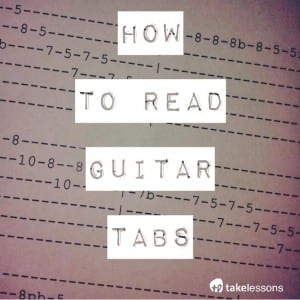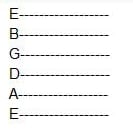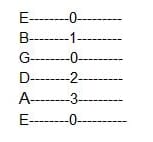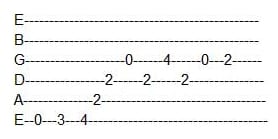 Although learning to read sheet music is a valuable skill for any musician, most guitarists prefer to use a different type of notation known as guitar tablature or guitar tabs. Guitar tabs give a basic visual representation of the neck of your guitar and use numbers to indicate which notes are to be played. Learning how to read tabs is pretty simple, and, once you get the hang of it, you can easily learn new songs or write down compositions of your own.
Although learning to read sheet music is a valuable skill for any musician, most guitarists prefer to use a different type of notation known as guitar tablature or guitar tabs. Guitar tabs give a basic visual representation of the neck of your guitar and use numbers to indicate which notes are to be played. Learning how to read tabs is pretty simple, and, once you get the hang of it, you can easily learn new songs or write down compositions of your own.
How to Read Tabs

Guitar tabs are composed of six lines, each line representing one of the six strings of your guitar. The top line always corresponds with your high E (or first) string and the bottom line always corresponds to your low E (or sixth) string.
To many beginners, the layout of tablature is confusing as it appears to be upside down when compared to the actual neck of your guitar. However, getting used to this arrangement will suit you well when you move on to learning how to read sheet music. This layout actually mimics sheet music by representing higher notes higher on the staff than low notes.
The note that you are meant to play will be shown as a number on the corresponding string. For example, if a song calls for you to play the 5th fret on the A string, you will see a number 5 on the second line up from the bottom. If you see a zero, play the string “open,” guitar terminology for a string played without holding down a fret.
When reading guitar tabs, do so from left to right, like you would read a book. Keep in mind that guitar tabs indicate the sequence of the notes but typically lack any notation that indicates the rhythm. It’s best to listen to the piece you are trying to learn as you look at the tab to get a feel for how long or short the notes should be.
Don’t confuse the numbers on tablature for the number of the finger on your left hand that you should use to hold down the fret! The numbers only refer to the fret where the string should be held down. If you’re having trouble figuring out fingering for a particular guitar tab, you might want to consult with a guitar teacher for more guidance.
Now that you know the basics of how to read guitar tabs, let’s look at reading chords and melodies.
How to Read Guitar Chords

When you’re reading guitar tabs, chords are shown as in the diagram at the left, with all the notes stacked on top of one another. Guitar tabs are read from left to right, and the note spacing indicates sequence. Any time you see notes in vertical alignment, this indicates that they should be played at the same time.
Can you name the chord shown in the diagram? If you said “C”, you are correct!
Try an Easy Guitar Riff

A guitar riff is a series of notes that is repeated throughout a song. Many catchy guitar riffs are instantly recognizable, and luckily for beginning guitarists, they can be very easy to play too.
Riffs in a guitar tab will look like the diagram to the left. Start from the left and work your way to the right, playing each note. With a little practice, the result should sound like this.
If you’re just getting started with guitar, don’t get frustrated if it takes you more than a couple tries to sound as good as the Beatles. Feel free to go slow and make mistakes.
Again, guitar tabs only show you the order of the notes; they do not show rhythm. To get a good feel for the rhythm of a song, it’s always a good idea to listen to a recording while you look over the tab.
Other Symbols in Guitar Tabs
As you learn how to read guitar tabs, you might start to come across letters and symbols in addition to numbers. Don’t worry, you’re not losing your mind! These letters and symbols are there to let you know about some special techniques that you need to employ to make the song sound like the original. Below are a few of the most common symbols you’ll come across and what to play when you see them.
Hammer Ons
You might see the letter H pop up between two numbers, something like this: 5-H-7. This represents a technique known as a “hammer on.” For the example shown, you would play the fifth fret note and while it is still ringing out, use another finger to press down the seventh fret on the same string. This technique results in a quick change between notes and is popular in guitar solos.
Pull Offs
Very similar to a hammer on, a pull off is notated with a P between two notes, like this: 7-P-5. To play the pull off in the example, play a note on the seventh fret. While you play the seventh fret, place another finger on the fifth fret and pull your finger off the seventh fret.
Slides
Slides are represented with a forwardslash or backslash between two notes, like this: 5/7 or 75. Basically, you hold down a note with one finger and while you’re playing the note, slide your finger up or down the neck of your guitar to the other note. A forwardslash indicates that you need to slide up the neck, while a backslash is used to represent a slide down.
Bends
Bends are another popular technique used in many guitar solos. Bends are represented in guitar tabs like this: 5-B-7. To play a bend, hold the note on the fifth fret and as you play, push with your left hand finger bend the string until the pitch changes to match the pitch the same string normally has on the seventh fret.
Vibrato
Vibrato, or a quavering effect, is achieved by rapidly bending and releasing the bend, a kind of vibration of your finger on the fret. When a piece calls for vibrato, you’ll see this symbol on the tab: ~
Muted Notes
In guitar tabs, when you see an x over a string, this indicates a muted note. To achieve this sound, hold your finger on the string without pressing down a fret. This creates a soft, “muted” sound.
As always, when you come across a special symbol in a guitar tab, listen to a recording of the song as you practice the technique. If you struggle with any of these techniques, a qualified guitar teacher can help you master them and incorporate new sounds into your repertoire.
For guitarists who want to see big improvements in their playing, nothing beats studying with a qualified guitar teacher. TakeLessons offers private, one-on-one lessons with the best teachers. Our teachers tailor your lessons to your needs, so you learn exactly what you want to. Search for your perfect teacher today or read more of our guitar resource articles.
You might also like…
–6 Common Questions About Beginning Guitar
–5 Easy Guitar Songs
–How to Tune a Guitar
-Megan L. TakeLessons Staff Member and Blogger
Photo Credit: The Hamster Factor
Megan L.

